pare ambroise (445 risultati)
Tipo di articolo
- Tutti gli articoli
- Libri (439)
- Riviste e Giornali
- Fumetti
- Spartiti (1)
- Arte, Stampe e Poster (5)
- Fotografie
- Mappe
-
Manoscritti e
Collezionismo cartaceo
Condizioni
Legatura
Ulteriori caratteristiche
- Prima edizione (59)
- Copia autografata (3)
- Sovraccoperta (43)
- Con foto (216)
- No print on demand (357)
Spedizione gratuita
Paese del venditore
Valutazione venditore
-
Cinq livres de chirurgie. 1. Des bandages. 2. Des fractures. 3. Des luxations, avec une Apologie touchant les harquebousades. 4. Des morsures & piqueures venimeuses. 5. Des gouttes. [Bound with:] Traicté de la peste, de la petite Verolle & Rougeolle: avec une brefue description de la Lepre
Editore: André Wechel, Paris, 1572
Prima edizione
Hardcover. First edition. TWO OF PARÉ'S MOST IMPORTANT WORKS. First editions of two of Paré's most important works, both very rare, and in fine condition. "The Cinq livres contains all new material. It had been called by several serious writers Paré's chef d'oeuvre . in it appears the first description of the fracture of the head and of the femur. Secondly, it is the first appearance of the whole teaching of bandages, fractures, and dislocations which has come down to us from the ancients, broadened by Paré's own experience . It is undoubtedly one of his most important works" (Doe 19). The Traicté de la peste was written from direct experience of the plague: "Having passed the winter of 1564-65 on tour in Provence with Catherine de Medici and the young king Charles IX, where the ravages of a plague epidemic, added to poverty and general misery, were painfully apparent, Paré was requested by the queen mother to make whatever knowledge he possessed of the disease available to the world. He therefore puts into a book his ideas as to its cause, transmission, and treatment, and says he writes only of what he has seen by long experience during his three years at the Hôtel-Dieu, his travels, his practice in Paris, and his own slight attack while he was serving his internship. This is one of Paré's most systematic treatises; for its careful symptomatology and thorough description of treatment, it deserves to rank among the best of his writings" (Doe 14). Both works are very rare. "Paré's original books, all very rare today, were handy volumes, small enough for the field surgeon's knapsack" (Hagelin, p. 35). ABPC/RBH list only two other apparently complete copies of the Cinq livres (Parke Bernet, 1963 & Sotheby's, 2016), and one of the Traicté de la peste (Sotheby's, 2005). Provenance: 'C.P.L.C. du bon desser' (contemporary ink inscription in lower margin of a2 recto); François Moutier (20th-century bookplate). "The barber-surgeons before Paré expected that any sort of surgical technique would require that the patient experience pain, sometimes pain so extreme that the subject would lose consciousness during the procedure. His realization that one might act gently in the capacity of a surgeon and that such gentleness actually might improve the lot of his patients was transformative. Pain relief was extremely limited in the 16th century - opium, henbane, mandrake, and strong spirits being the only offerings - and a quick, painful procedure often meant survival in a pre-antibiotic era. Tremendous pain was an accepted part of surgery. For Paré, the benefits of a gentle hand during surgery would soon become a clear means of reducing the suffering of his patients. "Paré made his break from the traditional practices in 1537 when he ran out of the boiling oil solution conventionally used to 'detoxify' and cauterize wounds caused by gunpowder-driven projectiles. He replaced this harsh treatment with a soothing balm made from egg yolks, rose oil, and turpentine. The next morning, he was astonished to find the recipients of his new treatment were resting easily while those who suffered the cauterizing oil were 'feverish' and afflicted with 'great pain and swelling about the edges of their wounds'. "Seeing the dramatic difference between the 'proper' and improvised treatments, Paré resolved to only treat cases with procedures he had personally observed to be useful. This resulted in such innovations as the use of ligatures in amputations, treatments for sucking chest wounds, and a cure for chronic ulcers of the skin. Although this experimentally driven medicine did not come to define the physician's practice until the rise of the Paris Clinic in the 19th century, these first writings established an important foundation of empiricism in European medicine" (Drucker). "Control of hemorrhage by ligation of arteries had been frequently recommended but it was Paré who first practiced it systematically and brought it into general use. He invented many new surgical instruments, devised new methods in dentistry for extracting teeth, filling cavities, and making artificial dentures. He describes an artificial hand from iron, and also artificial noses and eyes of gold and silver" (Hagelin, pp. 34-35). Janet Doe's bibliography makes special note of the scarcity of the Cinq livres: "Malgaigne, who could locate no copy of this book, makes an erroneous guess in ascribing to it Pare's book on tumors. It is extraordinary that no copy has come to light in recent years [Doe's work was published in 1937] till Haberling's report of the Freiburg one in 1928. Haeser, in 1881, mentions its existence; but Le Paulmier in 1884, Paget in 1897, and Packard in 1921 all refer to it as probably lost. This present census reveals fourteen copies extant, all but three of which are in large libraries" (Doe, p. 70). Doe lists the following copies: 1. Boston Medical Library. 2. Bibliothèque Nationale. 3. Bibliothèque Publique, Besançon. 4. Dr. Logan Clendining, Kansas City. 5. Dr. Harvey Cushing. 6. Bibliothek der Deutschen Gessellshaft für Chirurgie, Berlin. 7. National-Bibliothek, Vienna. 8. Royal College of Surgeons, London. 9. SÄ chsiche Landesbibliothek, Dresden. 10. Universitäts-Bibliothek, Freiburg. 11. Bibliothèque de l'Université, Louvain. 12. Biblioteca Apostolica Vaticana. 13. Dr. Erik Waller, Sweden. 14. Zentrabibliothek, Zürich. "Paré's account of plague, which was written at the request of the French queen-mother, Catherine de Medici, after a widespread outbreak of the disease in France in 1565, is one of the classic descriptions of the disease, and indicates how painful and fearsome it was. In Paré's view, the 'first original' of plague was a corruption of the air, entering the body and reaching the heart, 'the Mansion, or as it were the Fortress or Castle of Life', where it acted like a poison, attacking the vital spirit. If the vital spirit is weak, it 'flies back into the Fortress of the Heart, by the like contagion infecting the Heart, and so [it infe.
-
Traicté de la peste, de la petite verolle & rougeolle: avec une brefve description de la lepre
Editore: André Wechel, Paris, 1568
Prima edizione
Hardcover. First edition. THE PLAGUE, SMALLPOX, AND MEASLES. First edition of Paré's extremely rare treatise on the plague, smallpox and measles, based upon his own direct observations of these diseases, "one of his best works" (Thornton, p. 63). "Having passed the winter of 1564-65 on tour in Provence with Catherine de Medici and the young King Charles IX, where the ravages of a plague epidemic, added to poverty and general misery, were painfully apparent, Paré was requested by the queen mother to make whatever knowledge he possessed of the disease available to the world. He therefore puts into a book his ideas as to its cause, transmission, and treatment, and says he writes only of what he has seen by long experience during his three years at the Hôtel-Dieu, his travels, his practice in Paris, and his own slight attack while he was serving his internship. This is one of Paré's most systematic treatises; for its careful symptomatology and thorough description of treatment, it deserves to rank among the best of his writings" (Doe). "His practical measures in regard to hygiene and quarantine are excellent in most respects, although he followed the generally prevalent idea that bonfires of aromatic woods, such as juniper and pine, should be made throughout the streets to purify the air. He humanely urges that, 'The magistrates must have all sick folks attended by physicians, surgeons, and apothecaries, good men, of experience: and must treat those that are attacked and isolate them, sending them to places set apart for their treatment, or must shut them up in their own houses (but this I do not approve, and would rather they should forbid those that are healthy to hold any converse with them) and must send men to dress and feed them, at the expense of the patients, if they have the means, but if they are poor, then at the expense of the parish. Also they must forbid the citizens to put up for sale the furniture of those who have died of the plague'" (Packard, pp. 80-81). "Paré's original books, all very rare today, were handy volumes, small enough for the field surgeon's knapsack" (Hagelin, p. 35). COPAC lists Wellcome only. ABPC/RBH list only one other copy, in a rebacked 19th century binding and with the final four leaves re-margined (Sotheby's, 15 June 2005, lot 49, â 18,000). The present copy, in a 17th century binding, is entirely unrestored. "Because such a high proportion of those who suffered the symptoms of plague died from it, and in a very short space of time, it was not a disease to which people could ever become inured. Every outbreak appeared like a divine judgement. The medical men acknowledged this divine origin of plague. Ambroise Paré, surgeon to four French kings and the most celebrated surgical innovator of his day, devoted a chapter of his 1568 book on plague to 'the Divine causes of an extraordinarie Plague', claiming that: 'It is confirmed, constant, and received opinion in all Ages amongst Christians, that the Plague and other Diseases which violently assail the life of Man, are often sent by the just anger of God punishing our offences. The Prophet Amos hath long since taught it, saying Shall there be affliction, shall there be evil in a Citie, and the Lord hath not done it? On which we truly we ought always to meditate . For thus we shall learn to see God, our selves, the Heaven and Earth, the true knowledge of the causes of the Plague, and by a certain Divine Philosophy to teach, God to be the beginning and cause of the second causes, which well without the first cause cannot go about, nor attempt, much less perform any thing. For from hence they borrow their force, order, and constancy of order; so that they serve as instruments for God, who rules and governs us, and the whole World, to perform all his works, by that constant course of order, which he hath appointed unchangeable from the beginning. Wherefore all the cause of a Plague is not to be attributed to these near and inferior causes or beginnings, as the Epicures, and Lucianists commonly do.' [This and subsequent quotations from Paré are from the English translation of the present work, A Treatise of the Plague, London: Thomas Johnson, 1630.] "Thus only atheists and scoffers would claim that plague has only natural (secondary) causes. However the first cause - God - customarily acts through secondary causes, so Paré as a medical man could then immediately turn to the natural causes of plague to discuss its causes, course, and cure. "Paré's account of plague, which was written at the request of the French queen-mother, Catherine de Medici, after a widespread outbreak of the disease in France in 1565, is one of the classic descriptions of the disease, and indicates how painful and fearsome it was. In Paré's view, the 'first original' of plague was a corruption of the air, entering the body and reaching the heart, 'the Mansion, or as it were the Fortress or Castle of Life', where it acted like a poison, attacking the vital spirit. If the vital spirit is weak, it 'flies back into the Fortress of the Heart, by the like contagion infecting the Heart, and so [it infects] the whole Body, being spread into it by the passages of the Arteries'. The pestiferous poison brought about a burning fever, whose effects drove sufferers to desperate measures. They had ulcerated jaws, unquenchable thirst, dryness and blackness of the tongue, 'and it causeth such a Phrensy by inflaming the Brain, that the Patients running naked out of their beds, seek to throw themselves out of Windows into the Pits and Rivers that are at hand'. "Because he saw plague as a poison, a poison which acted on the heart and then on the blood, Paré's first concern in treatment was to provide an antidote, which by its specific property would defend the heart from the poison by opposing the specific power of the poison. It had to be quick-acting, since the poison itself was very swift. Paré's antidote of choice was a mixture of treacle and mithridatium, an ancient drug compoun.
-
(1) Cinq livres de chirurgie (2) Dissertatio de Febribus in genere (3) Tentamen medicum de variis calculorum biliarum speciebus, diversoque ab ipsis pendentium morborum genere
Editore: (1) Paris, chez André Wechel, 1572; (2) Montpellier, Apud Franciscum Rochard, Universitatis Typographum unicum, 1729; (3) Montpellier, Jean Martel, 1758, 1572
Da: Sokol Books Ltd. ABA ILAB, London, Regno Unito
Libro Prima edizione
Hardcover. Condizione: Very Good. 1st Edition. FIRST EDITION. 3 works in one volume. 8vo., pp. [xii] 470 [ii]. ã8,e4, a-z8, A-F8, G4. pp. (vi) 44. pp. (vi) 100. Roman letter, Italic side-notes. Title within charming woodcut border, grotesque woodcut initials and headpieces, portrait of the author within roundel on verso of t-p, 41 fine woodcuts of medical operations and instruments, anatomy etc., Le quatre mai mille sept cens soixante huit mss at head of title, C. Bergouhnioux ink stamp on a few leaves, Ex. Steedman BGA 1948 in pencil on verso of fly. Title page and verso of last dusty, very light waterstain at head of first leaves, the odd marginal stain or spot. A very good, clean copy, with good margins in early C19th vellum over boards for C. Bergouhnioux, (gilt stamped at base of spine) spine gilt ruled in compartments, fleurons gilt at centres, tan morocco label gilt, a little soiled. Very rare and important first edition of Ambroise Paré s greatest work, illustrated with a woodcut portrait of Paré at the age of 55 and 41 woodcuts depicting surgical operations and instruments. The Cinq livres contains all new material. It had been called by several serious writers Paré s chef d oeuvre. In it appears the first description of the fracture of the head and of the femur. Secondly, it is the first appearance of the whole teaching of bandages, fractures, and dislocations which has come down to us from the ancients, broadened by Paré s own experience. It is undoubtedly one of his most important works (Doe 19). This eminently practical work is very rare, even more so in good condition, as copies were undoubtedly much used in the field as a practical guides. Paré s original books, all very rare today, were handy volumes, small enough for the field surgeon s knapsack Hagelin. During the 1537 siege of Turin, a young French barber-surgeon abandoned the conventional wisdom about the treatment of bullet wounds, giving rise to a revolution in surgical techniques and pedagogy. Ambroise Paré . set the stage for the modern melding of scientific medicine and the invasive procedures that define surgery at the turn of the 21st century. The dogmatic quality of Galenism meant that physicians until the Renaissance and in many ways until the 19th century did not practice a medicine based on practical observation, experience, and empirical analysis. The treatments proscribed by Galen and the earlier Hippocratic writings were first comprehensively challenged by Paré and the anatomical writings of Paré s contemporary, Andreas Vesalius. Paré made his break from the traditional practices in 1537 when he ran out of the boiling oil solution conventionally used to detoxify and cauterize wounds caused by gunpowder-driven projectiles. He replaced this harsh treatment with a soothing balm made from egg yolks, rose oil, and turpentine. The next morning, he was astonished to find the recipients of his new treatment were resting easily while those who suffered the cauterizing oil were feverish and afflicted with great pain and swelling about the edges of their wounds . Seeing the dramatic difference between the proper and improvised treatments, Paré resolved to only treat cases with procedures he had personally observed to be useful. This resulted in such innovations as the use of ligatures in amputations, treatments for sucking chest wounds, and a cure for chronic ulcers of the skin. Although this experimentally driven medicine did not come to define the physician s practice until the rise of the Paris Clinic in the 19th century, these first writings established an important foundation of empiricism in European medicine. By writing in his native language, Paré was able to produce a series of volumes renowned for their clarity of form and easily accessible to his fellow barber-surgeons. His reliance upon the experiences of a long and notable career (he was often away at wars, attending high officials and, later, kings) gave his arguments heft.
-
Couverture rigide. Condizione: Très bon. Edition originale. PARE, Ambroise. DISCOURS D AMBROISE PARE, conseiller, et premier chirurgien du roy. Asçasoir, de la mumie, de la licorne, des venins, et de la peste. Paris, Gabriel Buon, 1582. In-4 de (16) ff., 75 ff, Daim fauve, double encadrement de deux filets, dos à nerfs, étiquette au dos, reliure moderne à l imitation des reliures du XVIe siècle ; angle supérieur de quelques feuillets restaurés et marge latérale du feuillet final découpé sans atteinte au texte, mouillures marginales. 224 x 165 mm. RARE EDITION ORIGINALE D AMBROISE PARE ET LE DERNIER DE SES LIVRES IMPORTANTS, RELIE SANS LE PORTRAIT DE L AUTEUR. Adams, P-316 ; Brun, p.267 ; Brunet, IV, 366 ; J. Doe, n° 24 ; Tchemerzine V, 39. Elle est ornée de 12 gravures sur bois en premier tirage dont six à pleine page représentant licornes, rhinocéros, éléphants et autres animaux fabuleux. Very rare first edition of Paré s tract against ancient medicine, denouncing empirical practices and illustrated with 12 beautiful woodcuts. EXEMPLAIRE NON LAVE, A BELLES MARGES.
-
Deux livres de chirurgie. I. De la génération de l'homme & manière d'extraire les enfans hors du ventre de la mère, ensemble ce qu'il faut faire mieux, & plus tost accoucher, avec la cure de plusieurs maladies qui luy peuvent survenir. II. Des monstres tant terrestres que marins, avec leurs portraits. Plus un petit traicté des plaies faites aux parties nerveuses
Editore: André Wechel [1572], Paris, 1573
Da: Hugues de Latude, Villefranche de Lauragais, Francia
Membro dell'associazione: ILAB
Prima edizione
*** Première édition. Elle est illustrée d'un portrait et 87 bois gravés dans le texte. Marque gravée de Wechel au dernier feuillet. La première partie traite de la génération et des accouchements. Ambroise Paré écrivit ce livre à la demande du duc d'Uzès qui l'interrogeait sur la génération et la conception des enfants. Cette partie s'achève sur les douleurs des dents et leur extraction. La seconde partie est consacrée aux monstres et c'est la première publication d'Ambroise Paré sur le sujet. Bien que de nombreux admirateurs de Paré ont rougi de la crédulité dont il fait preuve ici, Malgaigne a ardemment défendu la valeur de ces études tératologiques. Elles sont pour parti tirées de Lycostènes et Boaistuau, mais aussi d'observations personnelles, comme cette baleine qu'il a vu à Biarritz au cours d'un voyage en France à la suite du roi. A la fin, quelques chapitres sur la chirurgie sont ajoutés. Picot note que l'ouvrage, malgré sa date de 1573, a certainement était imprimé avant le 24 Août 1572, date du massacre de la Saint Barthélémy auquel a réussi à échapper Wechel, qui émigra alors définitivement et installa ses presses à Frankfurt. Tous les premiers ouvrages d'Ambroise Paré, des livres d'usage et de petit format, sont aujourd'hui rares. Picot, Catalogues James de Rotschild I, 108. Le livre a apparemment été relié au XIXe à l'aide de matériaux anciens. Très bel exemplaire. *** In-8 de (24), 619 pp. Maroquin brun, fleuron doré sur les plats, dos orné, tranches dorées. (Reliure du XIXe.) - - - - - - - - - - - - - - - - - - - - - - - - - - - - - - - - - - - - - - - - - - - - - - - - - - - - - - - - - - - - - - - - - - - - * First edition. Illustrated by a portrait and 87 woodcuts. Engraved printer mark on last folio. "This book contains fresh material." (Doe) The Duke d'Uzés talking one day to Paré about the formation and development of the fetus, begged him to write down for others what he had told the Duke. This is the first part of this volume, with at the end, two chapters on toothache and extraction. The second is a book on monsters, which appears here in its earliest form. "In spite of the fact that many of Paré's admirers have blushed for the credulity exhibited by him here, Malgaigne stoutly defends the work to teratological study inherent in these pathological description by Paré." They are partly taken from Lycostenes and Boaistuau, but also from personal observations, such as the whale Paré saw in Biarritz during a trip to France in the king's suite. At the end, some chapters on surgery are added. Picot notes that the work, in spite of its date of 1573, was certainly printed before August 24, 1572, date of the St. Bartholomew's Day massacre from which Wechel managed to escape, who then emigrated definitively and set up his presses in Frankfurt. All of Ambroise Paré's early works, which are practical books in small format, are today rare. Doe, A bibliography of the works of Ambroise Paré 20. Garrison Morton 543.51. The book was apparently binded in the 19th century using ancient materials. Very nice copy. - -.
-
Dix livres de la chirurgie avec le magasin des instruments necessaires à icelle
Editore: Jean Le Royer, Paris, 1564
Da: Hugues de Latude, Villefranche de Lauragais, Francia
Membro dell'associazione: ILAB
Prima edizione
*** Première édition. C'est le premier travail d'importance d'Ambroise Paré et son ouvrage de chirurgie le plus complet avant la parution des ses oeuvres onze ans plus tard. Il est illustré par 158 bois gravés, dont de nombreux instruments. Il existe deux tirages, dans l'un il y a un portrait au verso du titre, dans l'autre il est blanc ce qui est le cas ici, et cela pourrait être une marque de premier tirage. Plusieurs marges ont été restaurées et doublées, dont les feuillets 21 et 224, et les derniers feuillets de table, mais sans atteinte à la surface imprimée. Reliure restaurée. Les trois derniers exemplaires qui se sont vendus ces dernières années étaient tous incomplets. Tous les premiers ouvrages d'Ambroise Paré, des livres d'usage et de petit format, sont aujourd'hui rares. *** In-8 de (26), 232, (18) ff. Vélin. (Reliure de l'époque.) - - - - - - - - - - - - - - - - - - - - - - - - - - - - - - - - - - - - - - - - - - - - - - - - - - - - - - - - - - - - - - - - - - - - * First edition. Illustrated by 158 woodcuts. "Paré embarks here on his first work of magnitude." (Doe). "Paré's first general treatise on surgery, and the most comprehensive of his treatises before his collected works (1575). Dix livres included Paré's first description of the use of the ligature in amputations, one of his greatest contributions. Paré began the work with an exposition of his method of treating gunshot wounds, including descriptions and illustrations of the instruments he used. In his second chapter he discussed the treatment of arrow wounds, reminding us that arrows were still a major weapon of war in the 16th century. In his third chapter he discussed his methods of treating fractures, and the instruments, splints, and bandaging methods required. His fourth book covered the treatment of contusions, and the use of many instruments. His fifth book concerned the treatment of burns. The sixth book concerned what he called "caries of the bones" which caused ulceration and putrefaction. These wounds he often treated with cautery. The seventh book concerned gangrene and "mortification," their treatment by amputation, and prostheses which Paré designed for these patients, including artificial legs and artificial hands. In his eighth book Paré discussed urological diseases including surgery for urinary stricture The ninth book concerned surgery for kidney and bladder stones. The tenth book further discussed urological problems, followed by a long section in which Paré illustrated and described the widest range of his instruments and the uses for each. Paré also had an extensive dental practice and his books contain much information on the subject. He designed several instruments for extracting teeth." J. Doe, A bibliography of the works of Ambroise Paré 13. Garrison Morton 5564 and 3668.1. - -.
-
Les oeuvres d'Ambroise Paré, conseiller, et premier chirurgien du roy Divisees en vingt neuf livres, Avec les figures & portraicts, tant de l'Anatomie, que des instruments de Chirurgie, & de plusieurs Monstres. Reveuës & augmentees par l'Autheur, peu auparavant son decez Cinquiesme Edition
Editore: Veufue Gabriel Buon, Paris, 1598
Da: Arader Books, New York, NY, U.S.A.
Hardcover. Condizione: Good. Fifth. Fifth and best edition. Paris: Veufue (i.e., Veuve de) Gabiel Buon, 1598. Folio in 6s (13 3/4" x 8 11/16", 349mm x 221mm). [Full collation available.] Without the frontispiece portrait found in some copies. Bound in contemporary sprinkled calf. On the spine, six raised bands. Author gilt to the second panel. All edges of the text-block speckled red and brown. Hinges starting, with rubbing, scuffing, abrasion and loss throughout. Title-page trimmed and backed, with a filled loss at the lower edge (not affecting the image). Very mildly tanned throughout. Pressed plant at z5.6. Damp-stains to Pp6-Qq1, Qq6, Ss4-Tt2, TT5-Vv1, Xx4-DD6, LL6-OO3, PP6-TT2, YY5-EEe6, GGg1-HHh3, Iii6-LLl6 (an odd pattern, suggesting perhaps spills before binding). Large loss to the bottom edge of Yy1, not affecting the text. Worming to the lower margin of PP5-HHh2. A single marginalium to p. 1119 in an old hand: "diapalma." Ownership signature of "L DeJupilles" to the title-page as well as to p. 1189 (the end of the works of Paré) and to p. 1228 (the end of the text). Rare to find in contemporary binding, and the wear surely honest. Ambroise Paré (ca. 1509/10-1590) was (barber-)surgeon to four kings of France (Henri II, François II, Charles IX and Henri III, to whom the present work is dedicated), and is generally considered France's father of surgery. First published in 1575, the Oeuvres of Paré show the vast XVIc remit of a surgeon, viz., a doctor and natural scientist. He reintroduced ligation (tying off) in lieu of cauterization (burning) during amputation, a return to the practices of Galen that had been ignored for over a millennium. This 1598 fifth ("cinquiesme") edition is the first to contain the full complement of Paré's revisions, albeit applied posthumously. It is widely considered the "best" -- a hairy term in bibliography, but here clearly applicable -- and was the basis for Malgaigne's 1840 re-issue of the work. It is also quite rare, having come to auction five times (including one copy twice, as well as the present example). The work is best seen as a compendium of the high-water mark of medical (and quasi-medical) knowledge -- an entire course of training in a single volume. Paré treats anatomy extensively, with fine wood-cuts of veins and arteries as well as internal organs. He was working in the era of increasing use of firearms on the battlefield, and so came to be an expert in the treatment of wounds inflicted by projectiles as well as amputation; indeed, he includes diagrams of prosthetics of his own design. In addition to general topics such as gynecology, Paré also treats monsters (both humans born with atypical physiology) as well as the making of medicine, both compounding from simples (i.e., plant, animal and mineral substances) and distillation. The signature -- once to the title-page and once at the end of both parts of the work (the second "part" being an account of the life and travels of Paré, indicating, generally, that the work was in fact read -- is that of L(ouis?) de Jupilles. Jupilles is a commune in the Loire between Le Mans and Tours, and their lords bore that designation. More than that is difficult to ascertain. Doe, The Works of Ambroise Paré 32; not in Adams, Garrison-Morton, Waller or Wellcome.
-
Opera. A Docto viro plerisque locis recognita: Et Latinitate donata, Iacobi Guillemeau labore & diligentia.
Editore: Parisiis: Apud Jacobum Dupuy, 1582., 1582
Da: Sam Gatteno Books, Grosse Pointe, MI, U.S.A.
Libro
Hardcover. Condizione: Very Good. Folio in 6's. [xii], 1-884, [22]pp. a6, A6-DDd6, EEe4, FFf6, GGg5. First Latin edition, third edition overall, this being translated from the second French edition of 1579. Contemporary vellum. With the woodcut portrait of Paré on a4v and 362 woodcuts from the blocks of the 1575 Oeuvres with the additions of the 1579 edition. Doe, 45, a; Garrison-Morton 5565; Osler 661. Marginal repair to QQ4 not affecting text, at least 15 page mis-numberings. First edition in Latin of Pare's groundbreaking work, and the principal instrument of its huge success. 'This translation into Latin made the work immediately available to all the nations of Europe, since Latin was universally the language of the scholar' (Doe).
-
Opera. a docto viro plerisque locis recognita: latinitate donata Iacobi Guillemeau.
Data di pubblicazione: 1582
Da: Antiq. F.-D. Söhn - Medicusbooks.Com, Marburg, Germania
Libro Prima edizione
Paris: Jacques du Puys, 1582, Folio, [12], 884, [22] pp., woodcut device on title, half-page portrait of the author, numerous woodcuts throughout, text somewhat browned, contemporary blindstamped pigskin, clasps and catchplates. A fine copy in a beautiful period binding, with lesser Ink stain to lower gutter! FIRST LATIN EDITION OF PARE'S LANDMARK WORK, and the main instrument of its enormous success: 'this translation into Latin made the work immediately available to all nations of Europe, since Latin was universally the language of the scholar' (Doe). Pare's approach to surgery elevated to the status of scientific discipline what had been largely an ignoble practice. The cuts in this edition are those made for the first edition in French, supplemented by those produced for the 1579 edition. Ambrose Paré (c.1550-1590) is one of the fathers of French surgery, and also an important figure in the history of obstetrics. This translation and edition was made by his famous student Jacques Guillemeau, who married his daughter and ultimately succeeded him as royal surgeon to Charles IX, Henry III, and Henry V. Paré's collected works, first published in French in 1575, represent the greatest and most influential book in Renaissance surgery, and the first original surgical writing in Europe since the Middle Ages. Paré's innovations in treatment are extraordinarily comprehensive, ranging from his opposition to boiling oil in gunshot wounds and ligature instead of cautery in amputations to his revival of podalic version in obstetric deliveries of babies (birthing by means of the feet). He popularized the truss in hernias. He recommended the reimplantation of teeth, and described and illustrated the prostheses for the nose, eyes, hand, and penis. He preferred the artificial nose to rhinoplasty, although he discusses the latter. He classified burns, and described the pin-prick test still used to differentiate between full and partial thickness burns. His work also include the first illustration of the repair of harelip using a pin and twisted suture. "Paré used rope and windlass traction for femoral fractures and was able to distinguish hip dislocation from fracture of the femoral neck. He confirmed the cord compression in vertebral fractures" - Le Vay, History of Orthopedics, pp. 224-25; also 222-230). Further "Ambroise Paré introduced many innovations and made various observations that influenced the future development of neurological surgery to a great extent, although these contributions are less well known than his surgical achievements. " Bruno Splavski, et al.: Ambroise Pare' : His Contribution to the Future Advancement of Neurosurgery and the Hardships of His Times Affecting His Life and Brilliant Career". World Neurosurgery. 134 (2020) pp. 233-239 McDowell-Patterson, The Zeis Index I, 1878, 135, 136, 269, 2137; Zeis, Lit. Gesch.Palt. Chir., No.137, 281; Gnudi and Webster, p.123-125; McDowell, The Source book of plastic surgery, p.188-190, 257.Gurlt, Gesch. Chir. II, pp.688-784; Jane Doe, No.54. Adams P-313; Cushing P88; Doe 46; NLM/Durling 3531; Heirs of Hippocrates 163; Eimas 271; Osler 661; Waller 7175; Wellcome I, 482.
-
Les Oeuvres d'Ambroise Paré
Editore: Jean Gregoire, Lyon, 1664
Da: Cedar Tree Antiques, Upland, CA, U.S.A.
Libro
Hardcover. Condizione: Good. No Jacket. 12th Edition. LES OEUVRES DE AMBROISE PARE, CONSEILLER ER PREMIER CHIRURGIEN DU ROY by Ambroise Paré. Folio. 852 text pages + index. Contemporaneous full leather over boards. Spine is gilt stamped with raised bands and seven compartments. Hinges are sound. Pages browned, occasional small stains. Corners bumped. Top and bottom corners of spine and front edges of boards are rubbed. Page 653 damaged & taped, and laid over full blank page. No bookplate. Several "ex libris." in antique hand. All pages from 1-852 are present, as are all introductory pages, as well as the index. Thirty books in one volume with profusely illustrated with woodcuts. Covers diverse topics including anatomy, muscles, the skeleton, tumors, wounds of war, arthritis, gangrene, leprosy & plague, childbirth, bandages, fractures, distillations, surgical instruments, prostheses, and bizarre creatures. Ambroise Paré (1510 - 1590) was a barber-surgeon who served under the French kings Henry II, Francis II, Charles IX and Henry III. Barber-surgeons were not physicians, but were charged with caring for soldiers during and after battle due to their expertise with blades. Ambroise Paré is considered one of the fathers of surgery and modern forensic pathology. and a pioneer in surgical techniques. The first edition was published in 1575. This is the 12th edition, published in 1664, early in the reign of King Louis XIV.
-
Opera chirurgica (in the Latin translation by Jacques Guillemeau)."
Editore: "Frankfurt am Main, Johannes Feyerabend for Peter Fischer", 1594
Da: Mayfair Rare Books & Manuscripts Ltd, London, Regno Unito
Libro
Hardcover. Condizione: Good. "Folio (335x204 mm.), attractive contemporary blindstamped pigskin tooled on boards with multiple roll-borders, with small figures depicting the seven virtues and a central medallion showing the allegory of the Justice, red edges (lower corners of boards a bit work, edge of upper board ink spotted at top), for else in genuine condition, with a bookplate and stamps of a priv. collection on pastedowns, ms. ownership entries on flyleaf (one dated 1647). Large woodcut device on title and at the end, half-page woodcut portrait of Paré on leaf (:)4v, pp. [12], 851, [28 nn, of which last 3 are blanks], extensively illustrated with 317 text woodcuts of anatomical subjects, surgical instruments and procedures, monsters and freaks of nature, etc. Second collected edition in Latin of Paré's writings. Guillemeau's translation first appeared in 1582. Doe 48; Durling 3532.".
-
Les Oeuvres d'Ambroise Paré conseiller et premier chirurgien du Roy. Neuvième édition, revue et corrigée en plusieurs endroits et augmentées d'un forrt ample traité des fièvres. Avec les portraits et figures, tant de l'anatomie que des instruments de chirurgie et de plusieurs monstres.
Editore: Claude Rigaud et Claude Obert, 1633
Da: de KunstBurg, Gent, Belgio
Libro
Hardcover. Condizione: Good. Lyon, Claude Rigaud et Claude Obert, 1633. Neufiesme edtion, In-folio. Frontispice gravé, joli titre en rouge et noir, figures et portraits dans le texte. Deux ex-dono manuscrits du 19° siècle en tête de la page de titre, lettre (1 p. in-8°) de l'un des donateurs à son médecin encollée sur un des feuillets de garde. Illustré de plus de 300 gravures sur bois figurant des squelettes, des parties du corps et des organes, des animaux, des systèmes de distillation, des instruments, etc. Agréable exemplaire judicieusement restauré.relié maroquin brun , dos à nerfs, deux doubles filets dorés d'encadrement intérieur, étui bordé de même, dos et plats de l'étui recouvert du cuir de la reliure originelle de l'ouvrage. (quelques légères traces de mouillures claires marginales.). 1 volume.
-
De Chirurgie ende alle de Opera.
Editore: Harman Kranepol for Hendrick Laurensz, Haarlem, 1627
Da: Sanctuary Books, A.B.A.A., New York, NY, U.S.A.
Hardcover. Condizione: Very Good+. Folio (292 x 192 mm). Title printed in red and black with printer's device; in-text woodcuts throughout. Title with small loss affecting imprint repaired. Contemporary sprinkled calf gilt (rebacked preserving original spine and endpapers, some minor wear). Provenance: Jean Jacob de Gruytere (signature); Henri-Marcel Van Mock (signature, 17 February 1755); Dr. Leboucq (bookplate). Fourth collected edition in Dutch, a reprint of the 1604 edition, printed by the same printer as the 1615 edition with his device on the title-page. According to Doe, the Dutch editions were far superior to the "very inferior" Latin edition. The Dutch editions used the same woodblocks as the French editions. Paré, one of the most notable surgeons of the European Renaissance, is considered one of the fathers of modern surgery and forensic pathology, and was a pioneer in surgical techniques and battlefield medicine. Doe pp.193-4. Overall an exceptionally nice copy of this classic work.
-
Paris, Nicolas Buon, 1614. In-folio, [2]-1228-[118] pp., reliure pastiche composite, veau brun postérieur, frise estampée à froid en encadrement sur les plats, dos à nerfs orné de filets à froid et de fleuron dorés, auteur et titre dorés au dos, tranches mouchetées(reliure très restaurée, dos entièrement refait, petits manques et déchirures au 1er et dernier feuillets, erreur d'impression entre les ff. Ll1 et Ll3: 1 f. DD avec un petit manque de texte d'une vingtaine de mots, déchirure aux ff. i3 et i4) Septième édition comportant une mention de sixième édition, réimpression de celles de 1598 qui était la dernière que Paré a revue et corrigée avant sa mort en 1590. Elle débute sur un titre-frontispice architecturé portant le chiffre d'Henri III et de Catherine de Médicis (les initiales H et C entrecroisés) et contient de nombreuses gravures sur bois dans le texte, représentant des animaux, de l'anatomie humaine ou encore des instruments de chirurgie. Elle est abondamment ornée de bandeaux, culs-de-lampe et lettrines dans le texte, également gravées sur bois. "Recueil estimé" selon Brunet, il contient bien l'Apologie et ses exhaustive tables en fin de volume. Ex-libris manuscrit Charles Richet, daté du 26 juin 1925; ex-dono à son fils Gabriel. Tchemerzine, IX, p. 50; Brunet, IV, 366. * Voir photographie(s) / See picture(s).
-
Les uvres. Douziesme édition, reveuë et corrigée en plusieurs endroits, et augmentée d'un ample Traicté des Fièvres, tant en general qu'en particulier, et de la curation d'icelles, nouvellement trouvé dans les Manuscrits de l'Autheur. Avec les Voyages qu'il a faits en divers lieux: Et les pourtraits et Figures, tant de l'Anatomie que des Instruments de Chirurgie, et de plusieurs Monstres.
Editore: A Lyon, chez Jean Grégoire, 1664., 1664
Da: Último Capítulo S.L., Barcelona, Spagna
8 feuillets. 852 pages. 37 feuillets. (35x22,5 Cm). Plein veau postérieur. Dos lisse orné. Charnières et dos légèrement frottés. Douzième édition posthume de cet ouvrage important et connu d Ambroise Paré, chirurgien d'Henri II, roi de France. Paré n'est pas diplômé de la Sorbonne ni de Padoue. Il débute sa carrière comme barbier, puis poursuit son activité de "petit chirurgien" en suivant les troupes françaises dans le Piémont lorsque Francesco Ier revendique des droits sur le duché de Milan. Il acquit une certaine notoriété lorsqu'il extirpa adroitement, à l'aide d'une pince de forgeron, la pointe d une lance coincée dans le crâne de Francesco di Lorena, désormais connu sous le nom de "le balafré". Sa spécialité est devenue le traitement des blessures par balle. Lorsqu'il publie cet ouvrage pour la première fois en 1575, on l'accuse d'être un homme imprudent, très inexpérimenté et trop audacieux. Les médecins de la Sorbonne crient au scandale et demandent que l'ouvrage soit brûlé car ils considèrent que Paré joue avec les limites de la médecine et met en péril à la fois la vie des patients et la déontologie des médecins. Outre les thèmes plus traditionnels de la chirurgie, l'ouvrage traite également des "monstres" de la nature, illustrés dans le texte et définis par l'auteur. Ces prodiges sont plutôt des phénomènes contre-nature, comme une femme donnant naissance à un serpent ou à un chien ou un homme né avec des membres plus courts et un chapeau sur la tête. Nous avons la chance de pouvoir mettre en vente un exemplaire très bien conservé et sans défauts majeurs. Rousseurs et taches d'encre éparses. Quelques soulignements au crayon bleu dans le texte.
-
Collection of 100 Curious Old Woodcuts of Surgical Instruments, Modes of Operation, Etc.
Da: Minotavros Books, ABAC ILAB, Whitby, ON, Canada
Hardcover. Condizione: Very Good. No Jacket. 4to (266.7mm x 317.5mm). A collection of mid 17th century surgical woodcuts that appear in an early edition of The Works of that Famous Chirurgion Ambrose Pare Translated out of Latine and Compared with the French by Th[omas] Johnson (ESTC lists 4 editions printed between 1634 and 1678). Rebacked with new paper label on spine. [82] p.p. Includes 105 surgical woodcuts that show a variety of tools for sealing the wounds, scraping and extracting teeth; drawing out bullets; knives and saws used for dismemberment and amputation; treatment for and methods of setting fractures and dislocated shoulders and elbows, as well as woodcuts of facial prosthetics for the eyes and nose, and artificial limbs for a hand made with iron. Light rubbing to boards, edges with some spotted stains on front cover. Pages lightly foxed. Early ink stains and scribbling to leaves and endpapers with some offsetting from woodcuts. Otherwise in very good condition with interesting medical woodcuts of surgical techniques and tools. The famous French barber surgeon Ambroise Pare (1510-1590) was influential in treating soldiers wounds and advanced knowledge and best practices for battlefield medicine, including amputation and making prosthetics. He served several French kings beginning with Henry II to Henry III. 0.
-
Wund-Artzney, oder Artzney Spiegell des Hocherfahrenenund vad Weitberümbten Bern Ambrosii Parei/Kon. Mant. in Franckreich/onder der StattParyB Aller Fürtresflichen WundtArbts.
Da: Librairie Diogène SARL, Lyon, Francia
Frankfurt am Mayin, Ben Zacharia Palthenio/in Berlung Peter Fischers G. Erbe, 1650, 1 volume in-folio de 355x210 mm environ, 1 feuillet blanc non chiffré, 8 feuillets non chiffrés (titre en noir et rouge avec belle gravée) 1239 pages chiffrées, 8 feuillets non chiffrés (register), reliure sur ais de bois biseautés recouverts de peau de truie décorée à froid sur les plats, dos à nerfs, traces des liens de fermeture sur les plats (liens absents). Manques de papier avec manque de texte sur les 4 premiers et les 2 derniers feuillets et p. 1063 et 1093, des mouillures, des défauts de marge, manque de cuir sur le dos, et trous de ver sur le dernier plat et le dos sur le cuir et le bois, ouvrage rare. Contient des illustrations des instruments et techniques de chirurgie+autres nombreuses figures dans le texte. Ambroise Paré, né vers 1510 (ou 1509 selon les sources) au Bourg-Hersent, près de Laval, et mort le 20 décembre 1590 à Paris, est un chirurgien et anatomiste français.Ambroise Paré est le chirurgien des champs de bataille, il est souvent considéré comme le père de la chirurgie moderne. Il est l'inventeur de nombreux instruments. La généralisation alors relativement récente de l usage des armes à feu rend les chirurgiens familiers avec des plaies d'une sorte nouvelle, que l on cautérise au fer rouge ou à l huile bouillante au risque de tuer le blessé. Paré met au point la ligature des artères, qu'il substitue à la cautérisation, dans les amputations. « Je le pansay, Dieu le guarist. »On cite volontiers cette phrase modeste de Paré pour résumer sa philosophie (citation en moyen français signifiant : « Je le pansai, Dieu le guérit. »).
-
Les oeuvres d'Ambroise Pare' conseiller et premier Chirurgien du Roy. Douziesme edition
Editore: Chez Iean Gregoire, Lyon, 1664
Da: Coenobium Libreria antiquaria, Asti, Italia
In folio (cm 23 x 34,5 circa), pp. (16) + 852 + (66) di indice. Tutte le pagine finali con l'indice presentano ampi interventi di restauro ai bordi dei fogli a risarcimento di alcune mancanze. Le ultime 24 pagineÂsono mancanti di ampie parti del testo. I restauri marginali dei fogli sono inoltre presenti in altre pagine del volume, in particolare da pagina 800 a pagina 852 circa. Alcune pagine con diffuse fioriture. Legatura moderna in piena pelle. Moltissime illustrazioni in xilografia nel testo. Dodicesima edizione postuma di questa importante e notissima opera, proprio per l'iconografia in essa contenuta, stampata numerose volte e pubblicata in prima edizioneÂnel 1575.ÂAmbroise Pare' (1510-1590) decise di pubblicarla in francese, pur conscio dello stigma che ne sarebbe derivato, motivando la sua decisione nel testo introduttivo. L'opera tratta appunto dei "mostri" in natura - illustrati nel testo - definiti dall'A. "fenomeni che appaiono al di fuori del corso della natura", come un bambino nato senza un braccio, o un altro con due teste. I prodigi sono invece fenomeni che avvengono contro natura, come una donna che partorisce un serpente o un cane. Molte le illustrazioni presenti in particolare da pagina 646 a 660 di gemelli nati attaccati o di esseri con corpi deformi. Curiosa la figura a pagina 656 di un nato con gli arti piu' corti che presenta un cappello in testa, mentre tutti gli altri corpi sono presentati nella loro asettica nudita'. Per Ghadessi ("Portraits of Human Monsters in the Renaissance", p. 18) l'anonimato del bambino e' in qualche modo compromesso dal suo cappello che potrebbe consentire una sua riconoscibilita': "This item of clothing cancels his generic position as a mere case study and invites viewers to speculate about the possible identity of this boy".ÂAmbroise Pare'ÂfuÂchirurgoÂdi Enrico II, re di Francia. Non si laureo' alla Sorbona o a Padova. Inizio' la sua carriera come barbiere, proseguendo poi la sua attivita' come "chirurgo minore" al seguito delle truppe francesi in Piemonte quando Francesco I rivendico' diritti sul ducato di Milano. Si guadagno' una certa fama quando estrasse con destrezza, mediante una tenaglia da fabbro, la punta della lancia conficcatasi nell'orbita di Francesco di Lorena, detto da allora "lo sfregiato". Sua specialita' era la cura delle ferite da arma da fuoco. Nel 1552 fu chirurgo aggregato all'armata di Enrico II. Nel 1554 fu nominato "chirurgo maggiore". Quando pubblico' quest'opera nel 1575 fu accusato di essere un uomo "molto imprudente, molto inesperto e molto temerario" per avere sconfinato dall'ambito della chirurgia invadendo, secondo i medici della Sorbona, i campi della generazione dei corpi, della patogenesi, dei morbi, della natura e proprieta' dei farmaci. La facolta' della Sorbona fece istanza affinche' l'operaÂfosse messa al rogo ma questo non avvenne sia per la fama che Pare' aveva conquistato come medico, sui campi di battaglia, sia per la dedica ad Enrico III, terzo figlio maschio di Enrico II, con la quale si apriva la sua opera. ITA.
-
Oeuvres complètes d'Ambroise PARE revues et collationnées sur toutes les éditions avec les variantes, accompagnées de notes historiques et critiques et précédées d'une introduction sur l'origine et les progrès de la chirurgie en Occident du sixième au seizième siècle, et sur la vie et les oeuvres d'Ambroise PARE par J.F. MALGAIGNE ---- EDITION ORIGINALE DE CETTE EDITION DES OEUVRES COMPLETES D'AMBROISE PARE EDITEES PAR LE CELEBRE CHIRURGIEN DU XIXème SIECLE J.F. MALGAIGNE -- TRES BEL EXEMPLAIRE -- 3 VOLUMES (COMPLETE SET)
Editore: P., Baillière, 1840, 1840
Da: LIBRAIRIE Bernard MAILLE, PARIS, Francia
Prima edizione
Couverture rigide. Condizione: Très bon. Edition originale. ---- EDITION ORIGINALE ---- TRES BEL EXEMPLAIRE ---- GARRISON N° 59 ---- "THE BEST EDITION OF PARE'S WORKS EDITED BY J.F. MALGAIGNE, THE GREATEST SURGICAL HISTORIAN AND CRITIC WHOM THE WORLD HAS YET SEEN". (Garrison & Billings) ---- P., Baillière, 1840, 3 VOLUMES GRAND IN 8 reliés en demi-basane bleue marine, dos ornés de fers et filets dorés (reliure de l'époque), (quelques rousseurs), T.1 : 2 portraits, 351pp., 459pp., T.2 : (2), 811pp., T.3 : (2), 32pp., 878pp., 217 FIGURES dans le texte ---- HEIRS OF HIPPOCRATES N° 273 : "Edited by Joseph François MALGAIGNE, this three-volume set is THE DEFINITIVE EDITION OF PARE'S WORKS. A comprehensive work, it CONTAINS A LENGTHY HISTORICAL INRODUCTION TO THE DEVELOPMENT AND STATE OF SURGERY BETWEEN THE SIXTH AND SIXTEENTH CENTURIES, AN EXTENSIVE BIOGRAPHY AND BIBLIOGRAPHY OF PARE, AS WELL AS HIS COLLECTED WRITINGS. MALGAIGNE was an accomplished french surgeon and author and was described by John Shaw Billings as "the greatest surgical historian and critic whom the world has yet seen"**3970/B3-3969/Cart11.
-
Oeuvres complètes d'Ambroise Paré revues et collationnées sur toutes les éditions, avec les variants; ornées de 217 planches et du portrait de l'auteur; accompagnées de notes historiques et critiques; et précédées d'une introduction sur l'origine et les progrès de la chirurgie en Occident du sixième au seizième siècle, et sur la vie et les ouvrages d'Ambroise Paré, par J.-F. Malgaigne.
Editore: J.-B. Baillière, Paris, 1840
Da: Moroccobound Fine Books, IOBA, Lewis Center, OH, U.S.A.
Membro dell'associazione: IOBA
Libro
Hardcover. Condizione: Good. Three volume set. Hardcovers, rebound in cloth with original wraps bound inside. A former library set with occasional, marginal wormholes, the text otherwise clean and unmarked. "This three volume set is the definitive edition of Pare's works. A comprehensive work, it contains a lengthy historical introduction to the development and state of surgery between the sixth and sixteenth centuries, an extensive biography and bibliography of Pare, as well as his collected writings. Malgaigne was an accomplished French surgeon and author." [Heirs of Hippocrates 273].
-
Couverture rigide. Condizione: Bon. Pierre Pigray (ca.1531-1613), médecin, reçu maître en chirurgien en 1564, chirurgien ordinaire des rois Charles IX, Henri III et Henri IV, premier chirurgien des rois Henri IV et Louis XIII, celui qui procéda à l?embaumement d?Henri IV, élève et disciple d?Ambroise Paré, signataire du rapport d?autopsie d?Henri IV, doyen du collège en 1609. P.S., 31 décembre 1601, 1p in-4 oblong. Sur parchemin. Reçu pour le paiement de ses gages. Découpe sur la droite avec manque de texte en bouts de ligne. [330-2].
-
Les oeuvres. Divisees en vingt neuf livres, avec les figures & portraicts, tant de l anatomie que des instruments de chirurgie, & de plusieurs monstres. (Fragment). 5me édition.
Editore: Paris: Veufue Gabriel Buon,, 1598
Da: Krull GmbH, Neuss, Germania
Libro
Folio. Halbleder. Neu aufgebunden mit zeitgenössischen Materialien. Der Inhalt ordentlich bis gut. Die ersten Blätter wasserrandig und im Bund mit Spuren alter Klebestellen. Fragment mit 19 der 29 Bücher. Ohne Titelei, ohne Schlußblatt von livre III, ohne die 2 Anfangsblätter von livre XIX. Es liegt vor: L introduction; des animaux et excellence de l homme; l anatomie; des tumeurs en general; de tumeurs en particulier; des payes en general; .en particulier; des playes d hacquebutes; des ulceres, fistules et hemorrhoides; des bandages; des fractures; des luxations; de plusieurs operations de chirurgie; de la grosse verolle; del apetite verolle et lepre; des venins; des rapports; apologie et voyages. Kollation: Ohne Titelei; 7 nn Blatt (preface), Seiten 1 - 136, Seiten 247 - 450, Seiten 483 - 654, Seiten 691 - 814, 1177 - 1228. Etwa 189 Textholzschnitte, 34 Bordüren und 7 Schlußvignetten. 684 (von 1228) Seiten. Französisch 2500g.
-
Oeuvres Completes D Ambroise Pare revues et collationnees sur toutes les editions, avec les variantes
Data di pubblicazione: 1840
Da: Patrick's Rare Books, IOBA, Hudsonville, MI, U.S.A.
Membro dell'associazione: IOBA
Libro
Soft cover. Condizione: Very Good. Oeuvres Completes D Ambroise Pare revues et collationnees sur toutes les editions, avec les variantes; ornees de 217 plances et du portrait de l auteur; accompagnees de notes historiques et critiques, et precedees d une introduction sur l origine et les progres de la chirurgie en occident du sixieme au seizieme siecle, et sur la vie et les ouvrages d Ambroise Pare, par J.-F. Malgaigne. Tome Premier 1840, Tome Deuxieme 1840, Tome Troisieme 1841. Paris. Three quarto volumes, measuring approximately 10 x 7 x 2 inches, each in original brown paper publisher s wraps. Untrimmed bottom and fore-edges. Unopened top edges. Bindings tight. Text blocks clean and bright with mild scattered foxing. Illustrated with 217 black and white figures. Text in French. An important later printing of the collected works of Ambroise Pare, by a celebrated surgeon in his own right J. F. Malgaigne. Later protective mylars added, but not affixed to the books easily removed.
-
Couverture rigide. Condizione: Bon. Antoine Portail (ca.1530-1608), conseiller du roi, barbier puis chirurgien juré, chirurgien ordinaire de Charles IX et Henri III, premier chirurgien du roi Henri IV, il soigna la fracture de la jambe d?Ambroise Paré, signataire des rapports d?autopsie de Charles IX et Henri III. Il fut anobli par Henri IV. Il était originaire du Béarn. P.S. deux fois, 2 septembre 1601, 1p in-8 oblong. Sur parchemin. Reçu pour le paiement de ses gages. Au dos, une note, toujours d?une autre main, indique « pour servir de quittance ». Portail a signé là-aussi. Il manque une petite bande sur la droite, mangeant les derniers mots de la ligne. [330-2].
-
Oeuvres Completes d'Ambroise Pare. Revues et Collationnees sur Toutes les Editions, Avec les Variantes.par J.-F. Malgaigne.
Editore: Bailliere, Paris, 1840
Da: Jeffrey H. Marks, Rare Books, ABAA, Rochester, NY, U.S.A.
3 vols. 2 plates and illustrations in the text. 8vo, old half morocco and marbled boards. Definitive edition. "The best edition of Pare's works, edited by J. F. Malgaigne" (GM 59). Cushing P 87; Osler 660; Waller 7174; Doe 45. Light wear and scuffing; edges of boards on Vol. III bumped; occasional light foxing; but a very nice set/.
-
Pare. Sculptured plaque by Doris Appel
Da: Jeremy Norman's historyofscience, Novato, CA, U.S.A.
-
Ver. Condizione: Ver. Rústica. Lomos algo fatigados (primer y segundo tomos retocados). Parcialmente intonso. Texto en francés. 217 grabados y 1 retrato del autor. Introducción sobre el origen y progreso de la cirugía en Occidente y sobre la vida y obra de Paré por J. F. Malgaigne. Buen estado general. Paris, Chez J. B. Baillière. 459/ 811/ 878pp. 1840.
-
Couverture rigide. Condizione: Bon. Claude Rousselet (?-1601), docteur régent en la faculté de médecine de Paris, doyen en 1576-1577. Il semble que le fils de Claude Rousselet, François, ait épousé la fille d?Ambroise Paré, Catherine I (issue du premier mariage). P.S., 5 janvier 1570, 1p in-8. Sur parchemin. Quittance pour le paiement de sa rente. Celle-ci fut payée par François de Vigny, receveur des finances de la ville de Paris, l?ancêtre d?Alfred de Vigny qui fut anobli. Notons que les Haag, dans La France protestante (Paris, Cherbuliez, 1858, tome VIII), indiquent bien que François Rousselet est le fils de Claude Rousselet alors que Jacqueline Rousselet, seconde épouse d?Ambroise Paré, est la fille de Jacques Rousselet. A l?inverse, le docteur Le Paulmier et, à sa suite, les généalogies en lignes considèrent que Jacqueline et François sont frères et soeurs et donc enfants de Jacques. Enfin, Janis L. Pallister, dans l?introduction de sa traduction de Des Montes et prodiges, publiée en 1982, dit que François et Jacqueline sont les enfants de Claude Rousselet. Il nous semble toutefois qu?il faille plus faire confiance au travail des frères Haag qu?au travail du docteur Le Paulmier qui a quelques approximations. Il est d?ailleurs assez logique, quand on voit les mariages de cette époque qui se passaient principalement dans le même milieu, qu?au moins un des deux [François ou Jacqueline], voire les deux, soient l?enfant du médecin. [331-2].
-
Monstruos y prodigios (Spanish Edition)
Editore: Siruela, 1992
ISBN 10: 8485876687ISBN 13: 9788485876686
Da: GoldenWavesOfBooks, Fayetteville, TX, U.S.A.
Libro
Paperback. Condizione: new. New. Fast Shipping and good customer service.
-
OEUVRES COMPLETES D'AMBROISE PARE REVUES ET COLLATIONNEES SUR TOUTES LES EDITIONS, AVEC LES VARIANTES; ORNEES DE 217 PLANCHES ET DU PORTRAIT DE L'AUTEUR; ACCOMPAGNEES DE NOTES HISTORIQUES ET CRITIQUES, ET PRECEDEES D'UNE INTRODUCTION SUR L'ORIGINE ET LES PROGRES DE LA CHIRURGIE EN OCCIDENT DU SIXIEME AU SEIZIEME SIECLE, ET SUR LA VIE ET LES OUVRAGES D'AMBROISE PARE [Three volumes]
Editore: J.-B. Bailliere, Paris, 1840
Da: Second Story Books, ABAA, Rockville, MD, U.S.A.
Hardcover. Large Octavos, Three Volumes. In Good condition. Contemporary leather covers rebacked with modern leather, black labels and gilt lettering to spine. Some areas of discoloration and wear to original covers, bindings tight. Text block shows age toning and foxing to interior and edges. In-text black-and-white illustrations throughout. Ex-library copy with usual markings, including bookplates to front pastedown, institutional stamps to several pages and call number written in pencil. Marbled end pages. MF consignment. CONTENTS: Vol. I. (CCCLI, 459 pages) - Vol. II. (811 pages) - Vol. III (XXXII, 878 pages). MF Consignment. Oversized order. Additional shipping and handling may be necessary for expedited/international orders. Economy international shipping unavailable due to size/weight restriction(s). Contact seller if you have any questions. 1357312. Special Collections.


![Immagine del venditore per Cinq livres de chirurgie. 1. Des bandages. 2. Des fractures. 3. Des luxations, avec une Apologie touchant les harquebousades. 4. Des morsures & piqueures venimeuses. 5. Des gouttes. [Bound with:] Traicté de la peste, de la petite Verolle & Rougeolle: avec une brefue description de la Lepre venduto da SOPHIA RARE BOOKS](https://pictures.abebooks.com/inventory/md/md30057030116.jpg)
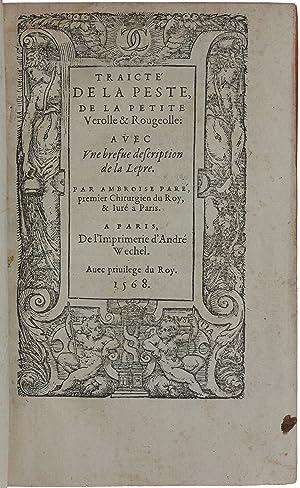
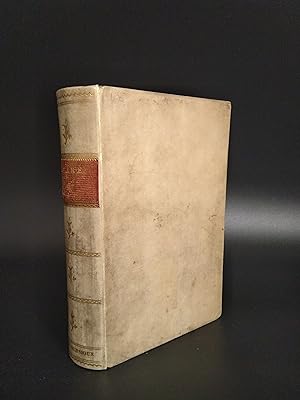
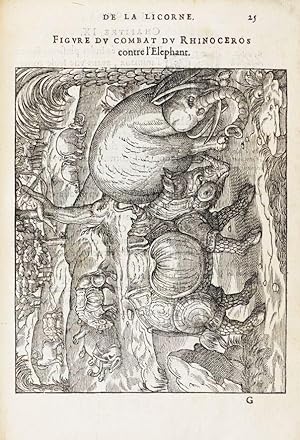
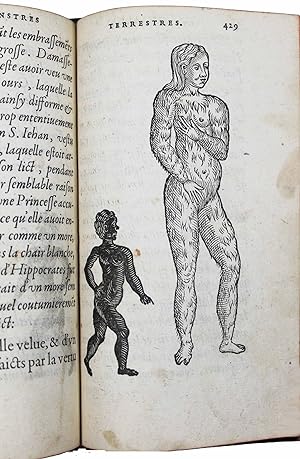
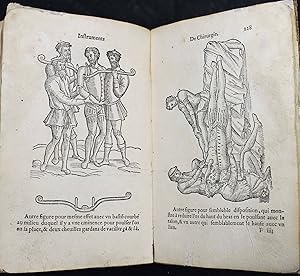

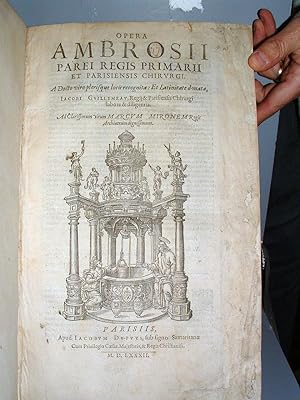
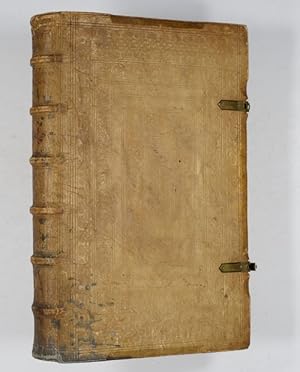
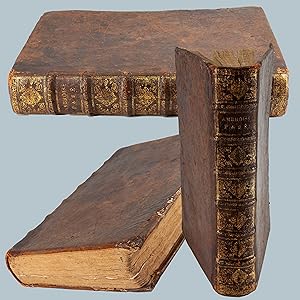

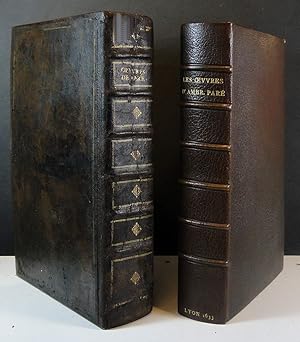
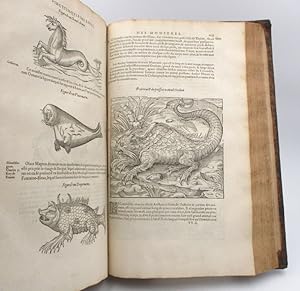
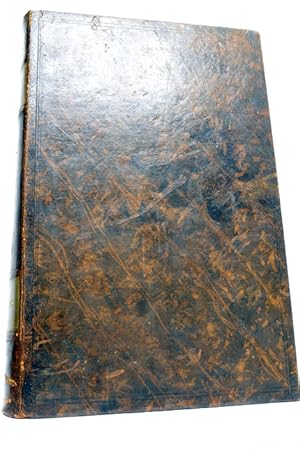
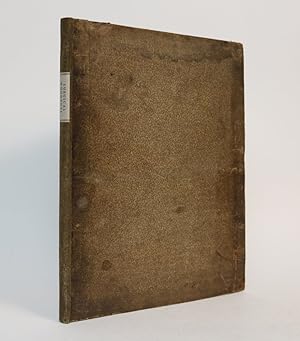
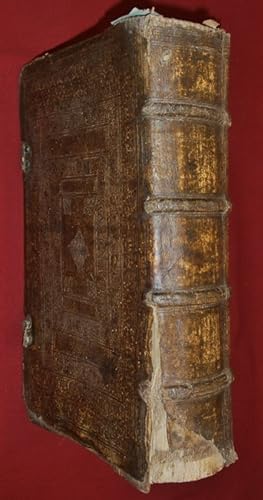
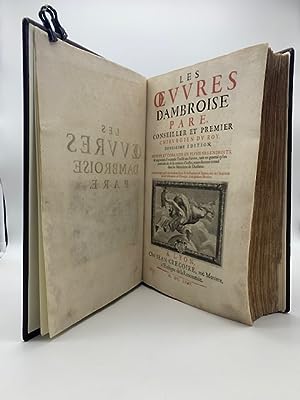
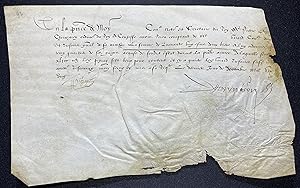
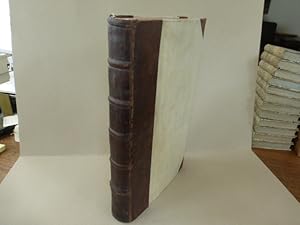
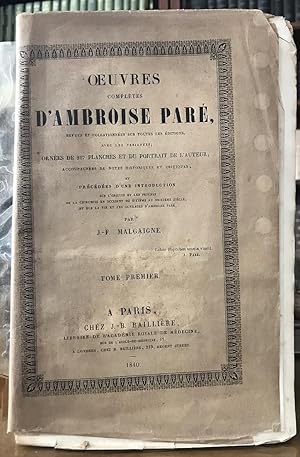
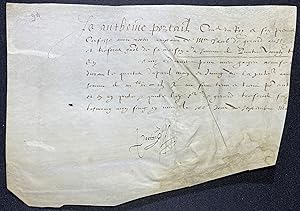
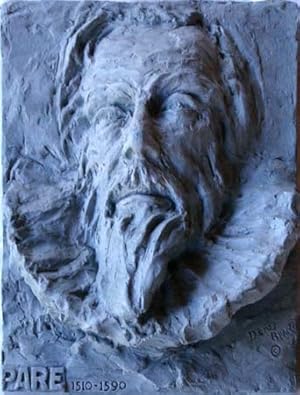
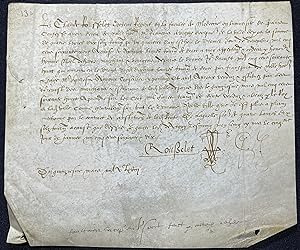
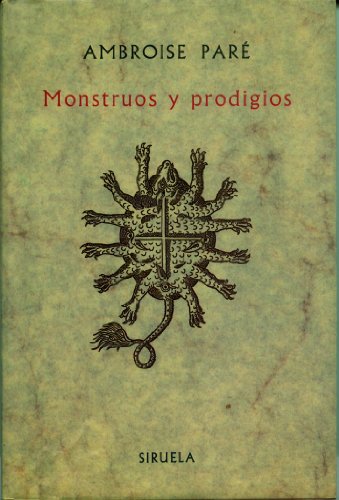
![Immagine del venditore per OEUVRES COMPLETES D'AMBROISE PARE REVUES ET COLLATIONNEES SUR TOUTES LES EDITIONS, AVEC LES VARIANTES; ORNEES DE 217 PLANCHES ET DU PORTRAIT DE L'AUTEUR; ACCOMPAGNEES DE NOTES HISTORIQUES ET CRITIQUES, ET PRECEDEES D'UNE INTRODUCTION SUR L'ORIGINE ET LES PROGRES DE LA CHIRURGIE EN OCCIDENT DU SIXIEME AU SEIZIEME SIECLE, ET SUR LA VIE ET LES OUVRAGES D'AMBROISE PARE [Three volumes] venduto da Second Story Books, ABAA](https://pictures.abebooks.com/inventory/md/md31281309054.jpg)